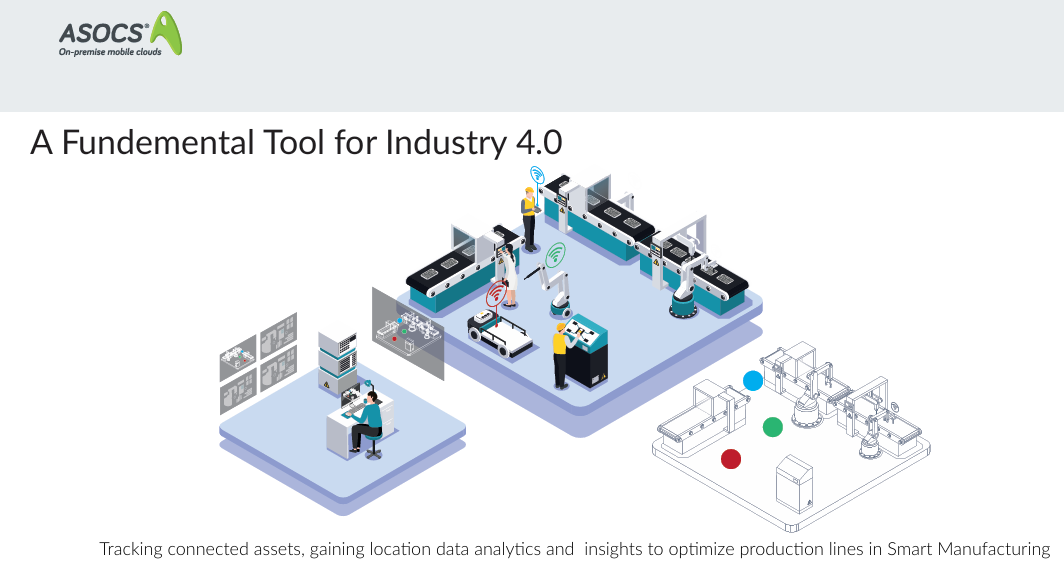ASOCS’ Flexible, Secure and Private 5G Network Model is Powering Manufacturing’s Industry 4.0 Future
ASOCS’ Flexible, Secure and Private 5G Network Model is Powering Manufacturing’s Industry 4.0 Future

5G is becoming the go-to technology for private networks, with enterprises, manufacturers, and system integrators implementing Private 5G in their facilities as the most efficient, manageable, and reliable method for transferring data from multiple simultaneously connected devices to and from the edge.
In the manufacturing world, 5G means factories and their production lines can operate at a faster speed, with greater throughput and lower latency. As the promise of Industry 4.0 becomes a reality, factories have become an interconnected web of devices, from robots to sensors and wearables generating valuable data for continuous improvement and decision-making. Without advances in 5G, it would be impossible for manufacturers to connect these devices and gather and transfer the data they collect while also maintaining reliability, latency, security, and mobility - all the benefits of fiber without the cables.
Embracing an Open Radio Access Network Model
In the past, traditional radio access networks (RAN) operated in proprietary silos and on proprietary hardware with connectivity governed by proprietary interfaces, provided by a single vendor. However, with the emergence of Open Radio Access Network (O-RAN) it is now possible for cellular network equipment provided by different vendors to interoperate, and for device owners to mix and match their technology to achieve their business objectives.
ASOCS has banked its business on O-RAN based on the belief that an open model was more flexible, easier to implement and valuable to enterprise customers. Focused on Industry 4.0 and the industrial/manufacturing sector, ASOCS’ CYRUS® 5G software enterprises to run their networks on their terms using standard hardware, just as they do with their IT infrastructure. This means that the manufacturers ASOCS serves can easily implement private 5G networks and benefit from high network reliability, enhanced security, and low latency.
“As governments began to slice out portions of the spectrum for enterprises, making it possible for companies to own a private network, the need became apparent to us that these businesses would need an online cloud-based solution for CU, DU, RU connectivity,” explains Shahar Haroush, COO at ASOCS. “Businesses need to run a network that is reliable, secure and fast like fibre, but without the cables. 5G is the go-to technology and private 5G is the go-to solution.”
Kaizen-Like Network Design Geared to the Manufacturing World
CYRUS 5G is based on three design pillars. The first is that O-RAN is now a commodity and brings disruptive capability to enable Industry 4.0. ASOCS integrates its software with multiple RU vendors, so its customers have a large range to choose from. The second pillar centers around constant improvement. ASOCS has no special hardware acceleration, ASICs or FPGA, meaning the company can continuously improve system performance and features and can push updates and upgrades to customers as they become available.
This approach meshes well with the Kaizen style philosophies so popular in the manufacturing world. The third pillar is that ASOCS is fully cloud-native. Running on VNF on VMWARE and Azure, and soon as a containerized solution on Kubernetes, ASOCS can scale at will through quick adjustments. By simply by adding instances users can rapidly adapt the platform to meet changing enterprise needs.
Shahar points to one of the company’s customers, a manufacturer seeking to manage an environment that includes both autonomous mobile robots and autonomous guided vehicles. They wanted to be able to adapt production lines in real time and swap out fixed assets, such as a robotic arm on one line and move it to another.
“Through the power of ASOCS’s platform, we were able to enable flexi-flow. Robotic arms could literally be pulled out of one line and added to another -- very plug and play - with no wires to disconnect and reconnect and no installation needed which means no lag time. For manufacturers where any downtime is a hit to the bottom line, this is powerful stuff.”
While ASOCS’s focus is primarily on Industry 4.0 the company is attracting customers from other sectors where private 5G networks are growing in popularity, including ports, educational campuses, transportation providers and healthcare.
“Interest has been wide and varied,” says Shahar. “Right up to being able to provide private 5G via satellite to remote locations.
ASOCS’s joined the Open 5G Innovation Lab ecosystem in September 2023 as part of the Lab’s 8th cohort.
“O-RAN, which is at the core of what we do is still in its early days in the US and there’s a steep learning curve,” explains Niv Zimmerman, VP Solutions. “So it was important as a company advancing O-RAN that we join together with others to push the market forward. The US is a huge manufacturing hub and it will be important for our future. Relationships we can foster through 5G OIL’s partners will be instrumental to our success.”
ASOCS hit $1.5M in revenue in 2023 and its ranks have grown to 7 offices worldwide, and the business is well capitalized with $24M in funding raised. It is a company that is poised for scale.
Says Shahar, “We’re facilitating the world’s transition to 5G communications and allowing enterprises to run their networks on their own terms. When the market fully catches up to us and recognized the value we bring, we’ll be ready to meet that demand.”





